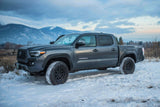Off-roading is all about pushing limits, conquering tough terrain, and feeling the thrill of the wild. But let’s face it, off-roading can be unpredictable. One moment, you're cruising through rugged trails, and the next, you're axle-deep in mud, stuck between a rock and a hard place, or bogged down in sand. That’s where off-road recovery comes in, knowing how to get unstuck is as crucial as the thrill of getting there.
In this comprehensive guide, we’ll dive deep into the art of off-road recovery, focusing on essential skills, tools, and techniques that can make the difference between a quick recovery and being stranded. Whether you’re a veteran off-roader or just starting out, this guide will equip you with the know-how to tackle the toughest recovery challenges with confidence.
Why Off-Road Recovery Matters
Getting stuck off-road is not a matter of if—it’s when. Off-roading presents challenges like slippery slopes, loose sand, thick mud, and uneven rock crawls. Without proper recovery skills, a fun day on the trails can quickly turn into a nightmare. Mastering off-road recovery allows you to not only rescue yourself but also assist fellow off-roaders, creating a safer and more enjoyable experience for everyone.
Essential Off-Road Recovery Gear
Before you can even think about recovering your vehicle, it’s vital to have the right tools at your disposal. Every off-roader should have a well-stocked recovery kit that includes the following essentials:
1. The Winch: Your Best Friend in Recovery
The centerpiece of any off-road recovery operation is the winch. It’s the muscle that pulls you out of sticky situations, whether you’re stuck in mud or wedged between rocks. Winches are rated by their pulling capacity, usually in pounds (lbs). For most off-road vehicles, a winch rated between 8,000 to 12,000 lbs is ideal. Always aim for a winch with a capacity that’s 1.5 times the weight of your vehicle, fully loaded.
- Synthetic Rope vs. Steel Cable: Synthetic ropes have gained popularity due to their lighter weight and safety under load, while steel cables are durable but can become dangerous if they snap. Choose based on your off-roading needs, but remember: proper handling is key for either material.
2. Recovery Straps
A recovery strap is a flexible tool designed to pull vehicles out of sticky situations. Unlike a tow strap, recovery straps are designed to stretch slightly, allowing for a smoother pull and reducing the risk of damage to vehicles. Ensure your recovery straps are rated for the weight of your vehicle, and never use them with a winch, as they aren’t designed to withstand the winch’s force.
3. D-Shackles and Soft Shackles
D-shackles (metal shackles) are the most common connection point between your recovery strap and winch, but soft shackles are becoming more popular due to their lightweight and versatility. Always use shackles rated for the load you’re pulling to ensure safety and efficiency.
4. Tree Savers
If you're winching from a tree, always use a tree saver strap. This wide strap wraps around the tree to prevent damage to the bark, which helps preserve the environment and ensures the anchor point stays strong.
5. Snatch Block (Pulley Block)
A snatch block can double the pulling power of your winch and is essential for more complicated recovery situations. It allows you to redirect the line, create mechanical advantages, and reduce strain on the winch motor.
6. High-Lift Jack
A high-lift jack isn’t just for changing tires, it can also help free a stuck vehicle by lifting it out of ruts or providing an anchor for winching in tough spots.
7. Traction Boards
When your tires lose grip in sand, mud, or snow, traction boards provide an extra surface for your tires to bite into, making it easier to drive out of the mess without winching.
8. Gloves
Recovery gear can be harsh on your hands, especially winch lines, so invest in a good pair of gloves to protect yourself during recovery operations.
How to Assess a Stuck Situation
Before jumping into action, take a moment to assess the situation. Rushing can lead to mistakes, injuries, or further damage to your vehicle. Here’s a quick checklist to follow:
- Stay Calm and Assess: Take a breath and assess the terrain around you. Are you stuck in mud, sand, snow, or on rocks? What’s the best direction to recover your vehicle?
- Check Vehicle Safety: Ensure your vehicle is in park or neutral (depending on your transmission type), and engage the parking brake. Use wheel chocks if necessary.
- Clear the Area: Make sure all passengers and bystanders are at a safe distance from the recovery zone. Winching lines under tension can snap, creating dangerous situations.
- Plan Your Pull: Identify the best recovery direction—usually back the way you came—and locate a solid anchor point, such as a tree, large boulder, or another vehicle.
Executing the Winch Recovery
With your plan in place and gear ready, it’s time to put your winching skills to the test. Here’s how to execute a safe and effective winch recovery:
1. Free Spool and Secure the Line
Set your winch to “free spool” mode and extend the cable or rope to the anchor point. Secure it using a shackle or tree saver. Make sure the line is straight to avoid binding or stacking on the drum.
2. Slow and Steady Wins the Race
When ready, engage the winch slowly. A smooth, steady pull is safer and less likely to cause damage. Don’t rush, winching should be a controlled process.
3. Spotting for Success
Your spotter is your eyes during recovery. Make sure to use clear signals or radios to communicate. The spotter should monitor the cable, watching for tension issues or if the vehicle is moving unevenly.
4. Double or Triple Line Pull for More Power
If a single line isn’t enough, use a snatch block to create a double or triple line pull, increasing the winch’s pulling power and reducing strain on the motor.
Advanced Recovery Techniques for the Off-Road Pro
For experienced off-roaders tackling extreme trails, basic recovery might not be enough. Here are some advanced techniques to add to your skill set:
- Self-Recovery: When no help is around, self-recovery becomes essential. Use trees, rocks, or ground anchors as winch points. Knowing how to use your gear effectively when solo can save you in a tight spot.
- Side Pulls: When straight-line recovery isn’t possible, use a snatch block to create a safe side pull, allowing you to maneuver out of tricky angles without straining the winch or vehicle.
Environmental Responsibility in Recovery
Responsible off-roading means respecting the environment. Always use tree savers when winching from trees, minimize damage to natural habitats, and pack out all your gear. Leaving no trace ensures the trails remain open for future adventurers.
Wrapping Up
Off-road recovery is more than just a skill, it’s an art form that every off-roader should master. With the right tools, techniques, and a calm approach, you’ll be able to handle any challenge the trail throws your way. And remember, recovery isn’t just about getting unstuck, it’s about doing it safely and responsibly. So gear up, hit the trails, and know that when things get tough, you’ve got the skills to get back on track.
Reaper Offroad Lifts has your back with top-quality lift kits to help you conquer the trails with confidence. Be ready for anything with gear built for durability and strength.




0 comments